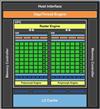NVIDIA announces the GeForce GT 430
posted:
10/11/2010 4:00:00 AM
More On:
GeForce GT 430
The Fermi architecture’s coming to you in a very, very inexpensive design with today’s release of the GeForce GT 430. If you’re like me and have an HTPC, this card might be THE one you pick up to put in your machine.
While the previous lineup using Fermi has been focused on gamers, the GeForce GT 430 is aimed at those owing digital media PCs. The GPU is based off the mobile version, GF108, which is already been shipped in multiple laptops today. While you’ll be able to pick this card up on its own, it’s mainly going to be acquirable with a pre-built system. Still, those wanting to upgrade their card only, like I am looking at, should be able to find one for sale.
On-board, the GeForce GT 430 holds 96 CUDA cores and 16 texture units, which is why NVIDIA is able to mark the price down on this card. The standard card comes with 1GB of memory but OEMs will be able to change that up a bit should they desire.Speeds are 1400MHz for the graphics core, 700MHz for the CUDA cores, and 1800MHz for the memory.
Because it’s Fermi, the feature set is going to be in line with the rest of the GeForce 4XX line. We’re talking DirectX 11 support, PhysX support, and 3D Vision. Now, I wouldn’t recommend using this card for any heavy gaming and 3D Vision, I would guess, would bring this card down to its knees seeing it has to render the left and right frames, but I am intrigued by the possibility of using this card as an inexpensive PhysX accelerator.
Now, what gets me excited about this card is the possibility of using it in an HTPC. I’ve used various ATI and NVIDIA cards in my setup and the only ones that never gave me any troubles were NVIDIA cards. The GeForce GT 430 has a full size HDMI connector on the bracket and support for HDMI 1.4 means you can use this card to outpiut 3D Blu-ray content. For audio, the latest drivers allow for Dolby TrueHD audio bitstreaming and DTS-HD Master audio. All these features at a very affordable price makes it one of the top items on my list to upgrade in my HTPC system.
It’s not going to be a main gaming card, but the GeForce GT 430 should be able to give you some gaming performance at lower resolutions with many settings turned down. But for me, I’m looking to get one to reduce the power requirements on my HTPC as well as increase the media capabilities as well.
While the previous lineup using Fermi has been focused on gamers, the GeForce GT 430 is aimed at those owing digital media PCs. The GPU is based off the mobile version, GF108, which is already been shipped in multiple laptops today. While you’ll be able to pick this card up on its own, it’s mainly going to be acquirable with a pre-built system. Still, those wanting to upgrade their card only, like I am looking at, should be able to find one for sale.

On-board, the GeForce GT 430 holds 96 CUDA cores and 16 texture units, which is why NVIDIA is able to mark the price down on this card. The standard card comes with 1GB of memory but OEMs will be able to change that up a bit should they desire.Speeds are 1400MHz for the graphics core, 700MHz for the CUDA cores, and 1800MHz for the memory.
Because it’s Fermi, the feature set is going to be in line with the rest of the GeForce 4XX line. We’re talking DirectX 11 support, PhysX support, and 3D Vision. Now, I wouldn’t recommend using this card for any heavy gaming and 3D Vision, I would guess, would bring this card down to its knees seeing it has to render the left and right frames, but I am intrigued by the possibility of using this card as an inexpensive PhysX accelerator.
Now, what gets me excited about this card is the possibility of using it in an HTPC. I’ve used various ATI and NVIDIA cards in my setup and the only ones that never gave me any troubles were NVIDIA cards. The GeForce GT 430 has a full size HDMI connector on the bracket and support for HDMI 1.4 means you can use this card to outpiut 3D Blu-ray content. For audio, the latest drivers allow for Dolby TrueHD audio bitstreaming and DTS-HD Master audio. All these features at a very affordable price makes it one of the top items on my list to upgrade in my HTPC system.
It’s not going to be a main gaming card, but the GeForce GT 430 should be able to give you some gaming performance at lower resolutions with many settings turned down. But for me, I’m looking to get one to reduce the power requirements on my HTPC as well as increase the media capabilities as well.




